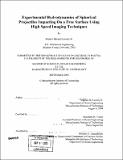Experimental hydrodynamics of spherical projectiles impacting on a free surface using high speed imaging techniques
Author(s)
Laverty, Stephen Michael
DownloadFull printable version (11.92Mb)
Other Contributors
Massachusetts Institute of Technology. Dept. of Ocean Engineering.
Advisor
Alexandra H. Techet.
Terms of use
Metadata
Show full item recordAbstract
This thesis looks at the hydrodynamics of spherical projectiles impacting the free surface using a unique experimental WebLab facility. Experiments were performed to determine the force impact coefficients of spheres and then compare obtained results to theories developed by Von-Karman [ 19] and Wagner [20]. It was found that experimental results matched a generalized Wagner approach developed by Touvia Miloh [12]. A critical impact speed for splash formation was determined before which no splash cavity would form. The cone angle formed behind an impacting object was also studied. The cone angle was found to be a function of depth and impact speed over the range of impact velocities tested. Steel spheres ranging in diameter from 0.64 cm (1/4 in) to 5.08 cm (2 in) were used at impact speeds from 0 to 6.9 m/s. Standard billiard balls of diameter 5.72 cm (2.25 in) were also used in this study. As part of this project, the WebLab facility was constructed. iMarine WebLab is an interactive teaching tool used to educate students in various aspects of marine hydrodynamics and experimental fluid mechanics.
Description
Thesis (S.M.)--Massachusetts Institute of Technology, Dept. of Ocean Engineering, 2005. Includes bibliographical references (leaves 78-80).
Date issued
2005Department
Massachusetts Institute of Technology. Department of Ocean EngineeringPublisher
Massachusetts Institute of Technology
Keywords
Ocean Engineering.